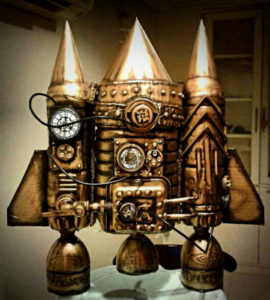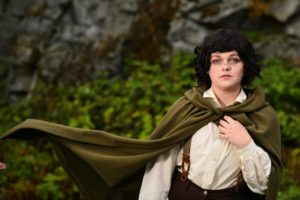Taking inspiration from comic books, movies, TV shows, novels, and video games, fans of pop culture worldwide share a passion for dressing up as their favourite characters—a passion for cosplaying. And the passion is alive and well here in Victoria.
It’s exciting for those who go ahead with the thrill of dressing up in cosplay gear and for those who attend conventions in their regular daily attire to see the costumes and perhaps pose for a photo beside the cosplayers who bring characters to life.
The first comic convention was held in New York in 1964, gathering a community of comic enthusiasts. The phenomenon grew immensely throughout the decades to include a wide range of art genres and formats, and comic cons are now held in various cities around the globe.
In Victoria, this year’s Capital City Comic Con was going to be held from March 20 to 22 at the Victoria Conference Centre; just before this issue went to press, the organizers announced it has been postponed due to the coronavirus. One of the event partners, Candice Woodward, has been working hard with the team of organizers to get everything ready. Woodward’s passion for pop culture and her personal involvement with everything that gets featured in an event such as Comic Con comes from her childhood, when toys and cartoons were really a big part of her life. Woodward delights in seeing the colourfulness of the convention with so many people dressing up.
“People are so creative; it amazes me when I see everybody’s outfits and they’re having a good time,” says Woodward. “That puts a big smile on my face.”
First-year Camosun Business student Richelle Clapp is passionate about cosplay and costume-making. It was only a couple of years ago that Clapp dressed up for the first time at Tsukino-Con at UVic. But before that, and for about eight years now, Clapp has been cosplaying her original characters inspired by her experience at an electronic music festival.
“I went to Shambhala and that was my first big exposure to steampunk and seeing people dressed up in those sort of costumes, and I just fell in love with the freedom that it had,” says Clapp. “Because steampunk is kind of this creation… It has a few guidelines but it’s pretty open to your own interpretation.”
When at events, Clapp enjoys both cosplaying and appreciating what others are dressing up as.
“That’s one thing I love taking pictures of, is everybody’s creativity,” says Clapp. “Most people make their own costumes, which to me as an artist makes it 100 times better, just to see what people create and come up with.”
Cosplayers come from all walks of life: for example, there’s early childhood educator and photographer Maddy Scott, who lives in Courtenay. When friends introduced Scott to cosplay culture in 2014, she found it an incredible match with the cartoons and animations she already enjoyed, as well as a great match with her love for dressing up.
“It was an experience like no other,” says Scott. “I was brought into an environment where I was immediately accepted for the things that I liked.”
Cosplayers inevitably have attention put on themselves when they dress up. With that in mind, Woodward understands that some people don’t want to be in the spotlight but can still admire the culture and participate in events.

“I find that a lot of people love to even see people in cosplay,” says Woodward. “Even if they don’t dress up themselves, they like to come and check out all of everybody else’s costumes.”
Clapp acknowledges that a lot of people may not go to conventions because they get scared by the thought that they’re expected to dress up, but she supports the idea of going just to see the costumes. For Clapp, cosplay has a certain freeing element to it.
“For me, it’s bringing characters to life, like people’s favourite characters from comics or movies or animes,” says Clapp. “They get to embody them for a day and take on these different characteristics, and there’s a freedom in that. Maybe the character you chose is someone that you aspire to be more like and that helps you kind of break out of your shell.”
In this sense, Woodward points out that cosplay culture doesn’t need to be intimidating.
“You can still dress up with something that is homemade, something that is bought in a store; you can absolutely put hours and hours and hours of effort into it, as well,” says Woodward. “So it’s a little bit of something for everyone.”
Scott says it feels good as a cosplayer to have people asking to take pictures of the costumes; she says that even for people who aren’t sure if they want to dress up themselves, it’s a welcoming community.
“My best friend, she doesn’t cosplay, she doesn’t dress up, but she comes with me to conventions, she follows me around,” says Scott. “And sometimes having that one friend in a group who isn’t dressed up, they’re incredibly helpful as far as, ‘Oh, I’ll hold your guys’ bags,’ or, ‘Here, I’ll grab that shot.’”
Support and appreciation for one another are two aspects that have led Scott to perceive the cosplay community as a safe space to be.
“A lot of the time in day-to-day life people are, I’m gonna say, shamed for some of their likes—‘Oh, you’re watching a children’s show; you’re watching a cartoon.’ But within the cosplay community there’s so much more love and acceptance, I find,” says Scott.
That’s also how Woodward describes her memories of when, years ago, she went all the way to Salt Lake City for the FanX convention.
“I think it was my first convention, and I loved the culture and the community,” says Woodward. “It’s just such a wonderfully supportive and creative community.”
Once Clapp had attended both Shambhala and Tsukino-Con, she noticed a lot of similarities between the two kinds of events.
“Music festivals and conventions give people the chance to be their true selves—they are not worried about being judged or laughed at,” says Clapp. “You can just be who you wanna be and I think it’s very freeing, and everybody, at both events, they are so happy, and they are just ready to meet new people and have an amazing experience.”
In terms of costume making, Scott says it may require hours of work to get a costume ready.
“I will sew things, but I will also [use] thrift store items,” says Scott. “So I will scavenge their stores to find items that are similar enough to what I’m looking for, and then with my sewing skills I will alter them to fit my needs.”
For Clapp, making costumes and props also involves a sustainable approach that has actually got her father to pay attention to her art.
“He thinks it’s super cool. I use a lot of recycled material, so he got to see the beginning stages, where it just looks like a pile of junk that I found off the street,” says Clapp. “But then when you put it all together and do the paint and the details, it turns into this really interesting piece, so it’s cool to see the process.”

Scott—who has a separate closet at home where she keeps all her costumes—sometimes benefits from an alternative to sewing and thrift shopping.
“Some of my costumes are second-hand from other cosplayers where they were no longer in use for that costume and I was someone who wanted it,” says Scott. “So you can sell them off to other cosplayers, or I’ll lend things out to friends, and there’s a huge sharing and supporting community amongst cosplayers for the costumes.”
Clapp says that one of the best costumes she’s ever seen was that of an outer-worldly creature crawling around with long legs; it was a young boy who was wearing it, and he had made the costume together with his family. Clapp can relate to this, as she has worked on a couple of costumes with her dad.
“We built a treehouse together, so he always loved building things and creating things, so I guess that bridged the gap and we could both work on it together and share our skills that we have,” says Clapp. “And he’s always been into sci-fi and that kind of thing, so it definitely appeals to him in that sense.”
Scott—who says that cosplay is a hobby that “requires a lot of skills and takes up your world”—admits that cosplay was a strange thing to introduce to her family, and she laughs at a memory of how her mom looked at her when picking her up from a convention for the first time.
“There’s definitely some people that don’t understand it,” says Scott, “but now my family is quite accepting of it, and very excited, like, ‘Oh, you’re gonna show me what you wore this weekend,’ and then, ‘Oh, what are you making? What are you working on?’”
There are often attendees spanning different generations at conventions; Woodward says that a family focus is very important at Capital City Comic Con.
“I think people are creative at any age and love to show their creativity,” says Woodward. “And then it’s really fun to see the families too, and when they do a group cosplay it’s really fun.”
Scott says that different generations of TV shows help attract cosplayers of all ages, giving the example of Doctor Who. She says that parents with young kids sometimes dress up together, even as characters that have kids.
“At Tsukino[-Con] there was a group of elderly—I wanna say 50 years plus—all dressed up as Harry Potter professors, Hogwarts professors, from the movies,” says Scott. “And it was beautiful to see because cosplay is not for one specific person, it is for all ages, all genders, and all skin colours. There is no restriction as in, ‘If you don’t look like the character you can’t be the character.’”
People dress up as a wide range of characters, and that can result in a lot of different situations. Woodward is appreciative of the various interactions that cosplay can foster.
“I think it’s really neat when you see someone and you’re like, ‘Hey, what is your costume?’ and they’re like, ‘Oh, that’s from a series that was done in, you know, years ago,’ that you wouldn’t have heard of, and then maybe you become interested in that comic series as well, which is really neat.”

Scott agrees that the interactions that cosplayers have around their costumes allow people to share their favourite series and learn from one another.
“Sometimes you really like somebody’s costume and you’ll say, ‘Oh my goodness, where is this from?’ Then from there you’ll be like, ‘Oh, it’s from Lord of the Rings’; “Okay, cool, what is it about?’and you find new things to get into, a new guide,” says Scott. “You can share interests of shows or movies with people and kind of grow your knowledge of, oh, the nerdy world, so to say.”
The excitement of seeing cosplayers is shared by novices and veterans, but Scott highlights the need for understanding about consent, especially amongst those taking the first steps into cosplay culture and conventions.
“Cosplay is not consent. People have to definitely check in and [ask], ‘Hey, can I hug you? I love your character, may I take a photo of you?’ And that’s a huge thing that my specific cosplay family is working on getting in the environment, that you have to have that connection of yes-or-no-answer questions before anything further,” says Scott.
An unfortunate experience for Scott at one convention was when a male photographer at Tsukino-Con was asking especially young females to pose in sexual manners; that was when the importance of consent with cosplayers was brought to Scott’s attention even more prominently.
“We got in over 35 different complaints from young girls saying that he touched them inappropriately or separated them from their groups,” says Scott. “And so he was actually now banned from [Tsukino-Con], and it’s horrifying the things that I’ve heard through that and keeping the cosplay community safe.”
Clapp says that cosplaying has always been a positive experience but, on the negative side, she recalls a bad approach of someone who once interviewed her for a local newspaper at a convention.
“They were just very strange questions—he asked me if I turned to cosplay because I had had a bad childhood,” says Clapp. “Or a lot of them seemed targeted to paint cosplayers like a sad, broken group of people trying to escape reality, which I think is quite the opposite of what it is.”
Despite some negative media coverage, Clapp believes that the way cosplay culture is portrayed is changing as more people try it.
“I think it’s definitely becoming more and more popular, and things that may have seemed nerdy or uncool in the past have now got this, like, second wind, like, ‘Oh, they’re actually extremely fun and freeing and awesome,’” says Clapp. “So I think people are losing the stigmas that a lot of these things have.”
Clapp believes that social media has a huge impact on cosplay culture and says that a lot of her favourite people to follow online are cosplayers, including some who post tutorials to show how much work actually goes into a costume.
“I follow some people that make a full suit of armour of foam and plastic and they use unsuspecting materials that get turned into, you know, movie-quality pieces, which is very cool to me,” says Clapp. “And I think it helps it gain popularity and gain momentum—it makes it more mainstream.”
Woodward agrees that social media helps cosplay culture to grow.
“I find that Instagram is really popular with cosplayers; you can really take some beautiful photos,” says Woodward. “There’s people that edit special effects into their photos and make them look amazing, and all those get shared and then everyone gets following, really.”

Scott’s online presence comes from her belief that social media is one of the main outlets of cosplay culture.
“We don’t always get to go to conventions and some people can’t afford them because they’re halfway across the States and X amount of dollars in plane tickets,” says Scott. “So social media is incredibly positive as far as sharing our experience as cosplayers.”
Clapp has been going to a lot of conventions lately; she was pleasantly surprised to find out that there were multiple conventions nearby.
“I guess I just didn’t look into [conventions]. I dressed up a lot at different music events that I would go to, so I was cosplaying a lot,” says Clapp. “But, yeah, I think it was a friend of mine that said, you know, they were baffled that I had never been to a convention yet.”
The hustle of getting off the island to attend this kind of convention elsewhere is something that motivated organizers to hold Capital City Comic Con in Victoria, but Woodward explains that the reasons go far beyond practicality.
“I think one of the reasons would be we have such a creative community here and we have so many talented artists and creators just on the island alone and locally,” says Woodward. “We really wanted to bring something to Victoria that we could grow and build, and become a really nice community for people on the island.”
Woodward claims that the beauty of Victoria and the nerd culture that exists here are a perfect match and a growing trend.
“People have been trying to get conventions going in the past year and we also have Phenomacon, a new one that just started out in Langford,” says Woodward. “So there’s such a vibrant culture here, [Capital City Comic Con] was something that we felt was needed.”
Woodward acknowledges that since the first Capital City Comic Con in 2018, there have been some challenges getting everything up and going, but she praises the team behind it all.
“We like to improve every year—that’s our main goal,” says Woodward. “It’s to make every year a little bit bigger, a little bit better, a little bit more organized, so that’s something that we strive for every year.”
The inspiration that pushes Woodward to move forward promoting pop culture and supporting cosplay through Capital City Comic Con comes from the support received from locals.
“We do this for the community—we do all the hard work for the community, because we are a non-profit,” says Woodward. “I would say just the supportive comments from people, getting those really fuels you to keep going.”
Besides her position in the Capital City Comic Con Enthusiasts Society—the local non-profit organization that puts Comic Con together in Victoria—Woodward owns Cherry Bomb Toys, a vintage toy store downtown.
“I’ve always been involved in anything pop culture—toys, obviously, collectibles—and, of course, the cosplay goes along with a lot of characters in the realms that I love,” says Woodward. “So I find cosplay just a wonderful creative outlet for people, which is great.”
Scott wears many hats; she was able to make a mini-documentary about cosplay when she was in a short film class. She also often takes photographs of cosplayers.
“When I go to conventions I dress up, but also to a lot of conventions I hold a media pass,” says Scott. “I go around and take photos of the other cosplayers, helping them boost their confidence in their costumes and then giving them memories to hold on to from that convention.”
Raygungirl Designs is Clapp’s costume business, through which she gets custom orders online and then gets to exercise her creativity.
“I’m still getting into the sewing side of things, but my passion is making props and these kind of crazy pieces that you wouldn’t find in other places,” says Clapp. “So I do a lot of steampunk costumes; my favourite thing is making large jet packs and ray guns and that kind of thing, but I also do a lot of cosplay and that’s really fun.”
Thinking about her future, Clapp wishes to do what she loves for a career, which would involve expanding her costume business.
“A lot of my projects end up being quite big and time-consuming,” says Clapp, “so if I were to gain momentum that would be so big for me.”
In this sense, Clapp’s main motivation to pursue post-secondary studies comes from her artistic entrepreneurial spirit.
“I’m taking some art courses as well because that is where my heart is,” says Clapp. “I have a few businesses myself, and I’ve always been bad at the business side of things; I’m good at the art part.”
The interactions within the cosplay world seem to play a key role in fostering pop culture, and, as such, they offer a clear message about the importance of a community mindset to the events in this industry. In parallel, the idea of consent certainly comes as a ground rule of understanding that allows for respectful entertainment and ethical media coverage.
Either as a hobby or as part of an industry, the fact is that cosplay boosts creativity and artistic expression. A lot of dedication goes into making the costumes and props, or at least scavenging to find them.
Most of all, every cosplay fan—and everyone, period—can benefit from the sense of multi-generational community that prevails when people get together and dress up like their favourite characters.

What a nice piece! I really did not stop to consider the amount of time and work that goes into crafting these costumes. It looks like it really becomes somewhat of a lifestyle for those into it. I will definitely appreciate them more from now on.
Very nice to hear the perspective of someone that is so passionate about it. Great job!